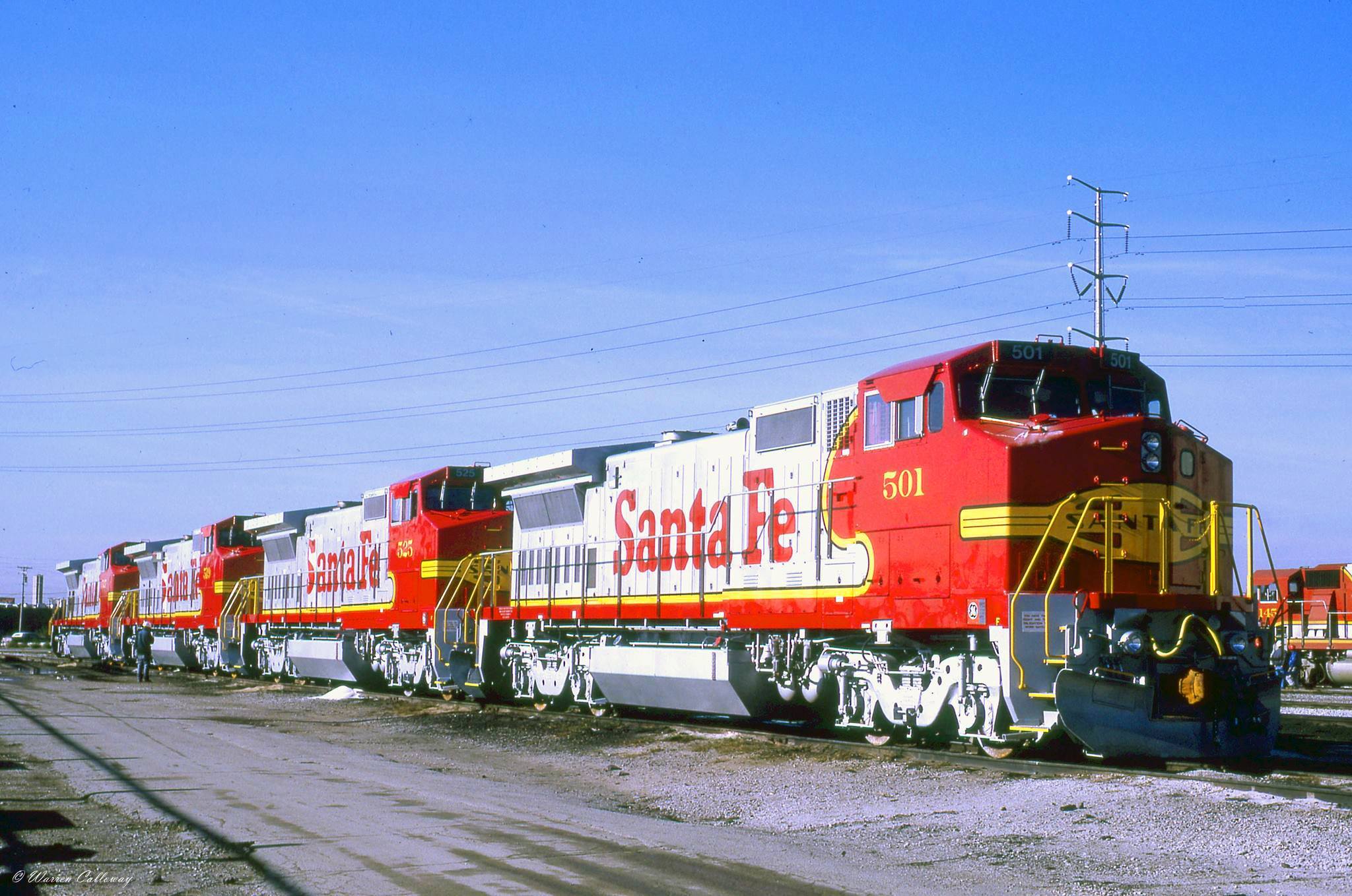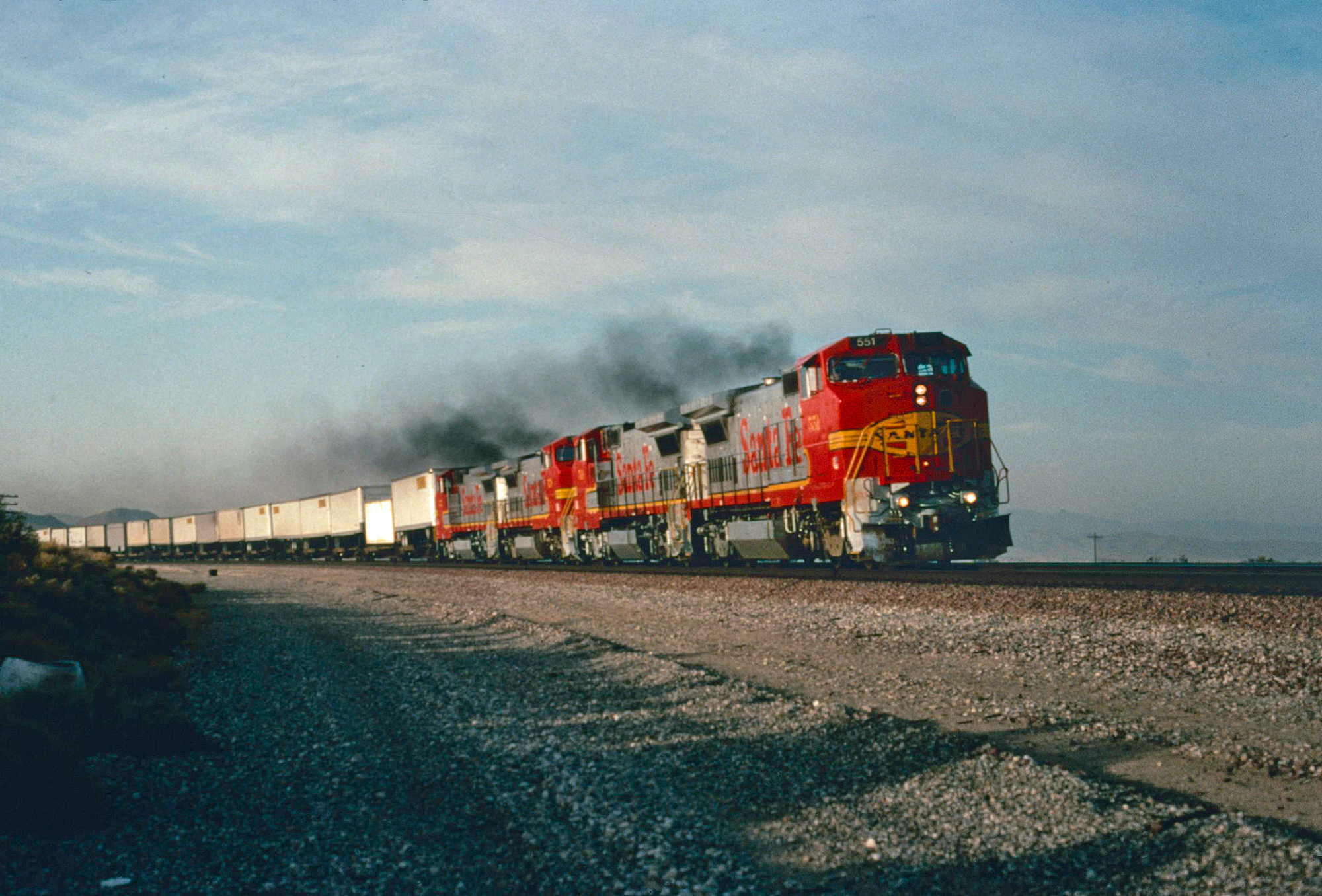GE "B40-8" and "B40-8W" Locomotives: Specs, Roster, History
Last revised: January 1, 2025
By: Adam Burns
The B40-8 and B40-8W (also known as the Dash 8-40B/W) was the single, most powerful four-axle design General Electric cataloged. It was also the company's last.
Built during the late 1980s, the model came in two versions using either the common Standard Cab or the newer, "North American Safety Cab."
By the early 1990s the wide cab became a required feature on new locomotives, mandated by the Federal Railroad Administration to increase crew protection in the even of a collision.
While sales for the 8-40B and Dash 8-40BW saw more than 230 units roll out of Erie during the late 1980s and early 1990s. Today, one can still find several examples operating on BNSF (B40-8Ws).
However, their time on the Class I is likely short; they have been in service for 30 years now and have not been extensively rebuilt.
Interestingly, the wide cab variants did make it into the BNSF livery. In addition, you can still catch examples on short lines and regionals.
Photos
 During the Santa Fe's late era the company elected to revived its classic Warbonnet livery. Here, four new Santa Fe B40-8W's show off the legendary paint scheme during October of 1990. Warren Calloway photo.
During the Santa Fe's late era the company elected to revived its classic Warbonnet livery. Here, four new Santa Fe B40-8W's show off the legendary paint scheme during October of 1990. Warren Calloway photo.Overview
The B40-8, otherwise referred to as the Dash 8-40B, was merely an uprated B39-8, one of General Electric's original prototype "Dash 8s" released in 1984.
As Brian Solomon notes in his book, "GE Locomotives," the B40-8 coincided with GE's latest "Dash" series, a somewhat confusing moniker meant to differentiate later Dash 8 models from the original "Classics."
To further add to the confusion, the company at first referred to its cataloged locomotives as "Enhanced" variants before changing this to the "Dash" series.
In any event, there were some internal improvements (such as microprocessor upgrades and enhancements to the 7FDL16 prime mover) but most changes were to the carbody; the prototypes had utilized a chassis with long hood very similar to the Dash 7s and redesigned cab while production Dash 8s featured a more streamlined layout.
The noteworthy differences here included a Standard Cab that was a flush with the roofline, a lower nose, equipment blower and dynamic brakes that seamlessly melded into the carbody, and angled radiator vents.
By the late 1980s both GE and Electro-Motive were having a difficult time finding a market for high-horsepower, four-motored locomotives (EMD's GP59 and GP60 models, for example, sold just over 400 examples combined).
These designs, of course, had been a mainstay of main line power from the late 1930s until EMD successfully demonstrated the advantages of six-motored models in the 1960s.
But there still remained a market for four-motored road-switchers into the 1980s, predominantly in high-speed freight service where six-axles were unnecessary. As a result, models like the Dash 8-40B continued to see some success.
As Greg McDonnell notes in his book, "Locomotives: The Modern Diesel & Electric Reference, 2nd Edition," sales for four-axle road-switchers dried up simply due to the increased weight of trains.
Data Sheet
| Entered Production | 4/1988 (Conrail #5060) |
| Years Produced | 4/1988 - 12/1991 |
| GE Class | B40-8, Dash 8-40B, Dash 8-40BW |
| Engine | 7FDL16 (16 cylinder) |
| Engine Builder | General Electric |
| Horsepower | 4000 |
| RPM | 1050 |
| Length (B32-8, Dash 8-32B) | 63' 7" |
| Height (Top Of Rail To Top Of Cab) | 15' 4 1/2" |
| Width | 9' 11" |
| Weight | 288,000 - 289,000 Lbs |
| Fuel Capacity | 3,150 Gallons |
| Air Compressor | 3CDC (Westinghouse) |
| Air Brake Schedule | 26L (Westinghouse) |
| Trucks | B-B |
| Truck Type | Floating Bolster FB2 (GE) |
| Truck Wheelbase | 9' 0" |
| Wheel Size | 40" |
| Traction Motors | 752AG (4), GE |
| Traction Alternator | GMG186, GE |
| Auxiliary Generator | GY27, GE |
| MU (Multiple-Unit) | Yes |
| Dynamic Brakes | Yes |
| Gear Ratio | 83:20 |
| Tractive Effort/Starting | 70,000 Lbs |
| Tractive Effort/Continuous | 68,000 Lbs at 18.3 mph |
| Top Speed | 70 mph |
Production Rosters
B40-8
| Owner | Road Number | Serial Number | Order Number | Completion Date | Quantity |
|---|---|---|---|---|---|
| Conrail | 5060-5089 | 45624-45653 | 1413 | 4/1988-5/1988 | 30 |
| Santa Fe | 7410-7429 | 45656-45675 | 1412 | 6/1988 | 20 |
| New York, Susquehanna & Western | 4002-4008 (Evens) | 45676-45679 | 1415 | 6/1988 | 4 |
| St. Louis Southwestern (Southern Pacific) | 8040-8074 | 45688-45722 | 1414 | 7/1988-11/1988 | 35 |
| Santa Fe | 7430-7449 | 45931-45950 | 1416 | 4/1989 | 20 |
| New York, Susquehanna & Western | 4010-4048 (Evens) | 45951-45970 | 1417 | 4/1989 | 20 |
| St. Louis Southwestern (Southern Pacific) | 8075-8094 | 45971-45990 | 1418 | 5/1989 | 25 |
| U.S. Department Of Energy (Savannah River Site) | 107 | 46115 | 1420 | 5/1989 | 1 |
B40-8W
| Owner | Road Number | Serial Number | Order Number | Completion Date | Quantity |
|---|---|---|---|---|---|
| General Electric (Demonstrator) | 809* | 42999 | 1301-1 | 1988 | 1 |
| Santa Fe | 500-559 | 46404-46463 | 1422 | 10/1990-11/1990 | 60 |
| Santa Fe | 560-582 | 46906-46928 | 1431 | 3/1992 | 23 |
* The original Dash 8 prototype, original numbered 606 and built in 1982. Upgraded to 3,900 horsepower in 1986 and sported the original "North American" wide cab in 1989. Never sold.
Sources
- Foster, Gerald. A Field Guide To Trains. New York: Houghton Mifflin, 1996.
- Marre, Louis A. and Pinkepank, Jerry A. Contemporary Diesel Spotter's Guide, The: A Comprehensive Reference Manual To Locomotives Since 1972. Milwaukee: Kalmbach Publishing Company, 1989.
- McDonnell, Greg. Locomotives: The Modern Diesel & Electric Reference, 2nd Edition. Buffalo: Boston Mills Press/Firefly Books, 2015.
- Solomon, Brian. American Diesel Locomotive, The. Osceola: MBI Publishing, 2000.
- Solomon, Brian. GE and EMD Locomotives: The Illustrated History. Minneapolis: Voyageur Press, 2014.
- Solomon, Brian. GE Locomotives: 110 Years Of General Electric Motive Power. St. Paul: MBI Publishing, 2003.
 A quartet of Santa Fe B40-8W's lead trailers west over the Transcon main line at Hodge, California on the evening of September 12, 1993. American-Rails.com collection.
A quartet of Santa Fe B40-8W's lead trailers west over the Transcon main line at Hodge, California on the evening of September 12, 1993. American-Rails.com collection.By the 1980s, outside of some perishable and auto part business, expedited railroad service had largely been relegated to intermodal double-stacks. These trains were very heavy and four-motored locomotives simply could not handle such weights at the speeds required.
As a result, the industry moved away from such designs permanently in favor of their six-motored counterparts. Since the early 1990s, neither EMD or GE has offered a four-motored locomotive.
General Electric built just 155 B40-8s for Conrail, Santa Fe, St. Louis Southwestern and the New York, Susquehanna & Western. In addition, the Department of Energy purchased a single unit.
The model was also the first to feature GE's new North American Safety Cab, a now-standard wide cab design. The Santa Fe acquired 83 examples in the early 1990s and these units regularly handled fast freights across the West.
Recent Articles
-
Massachusetts - Wine Tasting - Train Rides
Dec 26, 25 03:37 PM
This article dives into some of the alluring aspects of wine by rail in Massachusetts, currently offered by the Cape Cod Central Railroad. -
Maryland - Wine Tasting - Train Rides
Dec 26, 25 03:34 PM
This article delves into the enchanting world of wine tasting train experiences in Maryland, providing a detailed exploration of their offerings, history, and allure. -
Florida Thomas The Train Rides
Dec 26, 25 03:32 PM
Each year, Day Out With Thomas™ turns the Florida Railroad Museum in Parrish into a full-on family festival built around one big moment: stepping aboard a real train pulled by a life-size Thomas the T…



